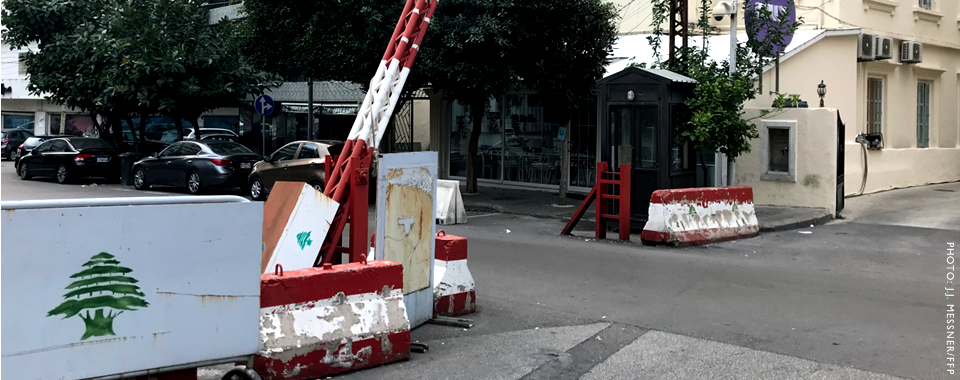BY WENDY WILSON
Once the scene of a deadly civil war, Lebanon has more recently been hailed for its resilience, having endured the region’s geopolitical upheaval, staved off the revolutionary tide of the 2011 Arab Spring, and seemingly absorbed the spill over effects of the Syrian Civil War. This celebrated resilience – based on the country’s perceived economic and financial strength in the face of shocks and a strictly defined ethno-religious social contract that has prevented a backslide into civil war – has been rocked, pulling back the curtain on Lebanon’s structural vulnerabilities. Though Lebanon’s overall Fragile States Index (FSI) score remained largely stable in 2020, the country saw declines in various indicators, most of all the Economy indicator, which worsened by one full point.
Lebanese citizens stormed the streets of Beirut in October 2019, in response to a proposed tax on WhatsApp calls. This movement would thus evolve into months of nationwide protests, the largest since the 2015 “You Stink” movement over issues of governance and garbage collection. The proposed tax, along with a series of austerity measures, were Beirut’s solutions to tackle the acute economic pressures that had Lebanon hurtling towards financial collapse. However, for the protestors, these measures were short-sighted responses which favored the elites at the expense of the poor and middle class, thereby failing to address longstanding underlying economic issues.

Following the end of the 15-year civil war in 1990 that decimated its socio-economic infrastructure, the Lebanese government of Prime Minister Rafiq al-Hariri launched an ambitious reconstruction program meant to restore infrastructure and revive the economy. The recovery program, accompanied by macroeconomic stabilization policies to address inflation and the various currency crises of the war period, was financed by internal and external borrowing, laying the groundwork for Lebanon’s eventual rise as one the world’s most indebted nations. The Hariri-led reconstruction effort yielded immediate post-war economic growth. However, Beirut’s subscription to certain fiscal, monetary, and central bank policies ultimately failed to foster long-term economic growth at a pace needed to reduce the balance of payments deficit. Against the backdrop of budget deficits and a growing public debt, a reduction of tax rates to attract investment led to budgetary austerity which, in turn, led to the use of indirect taxes to account for budgetary shortfalls, and reduced investment in social services. Additionally, subsidies to commercial banks and attractive interest rates to foreign depositors to shore up foreign currency reserves resulted in huge fiscal costs, with the payment of high interest rates by the central bank failing to garner enough returns for interest and capital repayment. The dollar peg also proved to be problematic in the long-term, gradually depleting dollar reserves. Such policies and practices, along with the clientelist nature of the political structure, resulted in an unproductive rentier economy and undiversified productive sector that favored elites, entrenched inequality, and worsened poverty levels. According to a World Inequality Database study, the top 10 percent of Lebanese earners amassed, on average, 56 percent of the total income earned from 2005 to 2014, while the bottom 50 percent accounted for 11 percent in the same time period.
The Lebanese economic model, after years of mounting issues, found itself in a truly precarious position in 2019. Its account deficit stood at approximately 25 percent of GDP, according to the IMF. Stagnating growth and reduced inflows of remittances placed it at risk of defaulting on its large debt load, estimated at 50 percent of government revenues.[1] The central bank faced challenges in maintaining the dollar parity and resorted to the hoarding of U.S. dollars due to shortages, resulting in low confidence and a rising black market exchange rate. As of mid-September, Lebanon’s foreign currency reserves had fallen by 17 percent from 2017’s record high of US$36.8bn.[2] The negative economic trends are reflected in a significant worsening of the Economic Decline indicator, with Lebanon as the most worsened state under this indicator in the 2020 FSI.
Years of perceived government mismanagement and inability to efficiently address the mounting economic problems, and the resulting pressures of the Syrian Civil War that pushed Lebanon towards the precipice of financial collapse in 2019, emboldened the disaffected citizenry to confront the other pillar of Lebanese resilience: political sectarianism. Specifically, the economic protests that began in October transformed into mass non-sectarian anti-government protests, an unprecedented move in post-war Lebanon. Thunderous chants of “all of them means all of them”, demands for a complete overhaul of the sectarian structure, rare demonstrations in Hezbollah strongholds, and the firm rejection of austerity measures illustrated the fervour and scale of public anger, plunging Lebanon into a political crisis. For protesters, political sectarianism was a double-edged sword, with the associated unfavorable consequences far outweighing the positives. The resulting clientelism, corruption, and recurrent political stalemates were viewed as contributing to the descent into economic freefall.
Lebanon now finds itself at a pivotal moment in its trajectory as the economic crisis and the anti-sectarian protests place it at a strategic crossroads. While past crises have been averted with the help of Gulf governments who have worked to shore up investor confidence, Beirut is unlikely to escape this current crisis with similar stopgaps. Given the sheer magnitude of the economic situation, set to be worsened by the COVID-19 pandemic, and the uncertain support from Gulf allies, the country will be forced to usher in long overdue credible reforms, to implement sustained fiscal policies to broaden its tax base and to remove widespread exemptions in order to stimulate growth and improve the odds for an inclusive and sustainable recovery. As the instability from late 2019 spills over into 2020, Lebanon’s performance will likely seriously worsen in the 2021 FSI.
Endnotes
1. URL located at: https://www.ft.com/content/c15c88de-fa35-11e9-98fd-4d6c20050229
2. Ibid.
